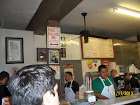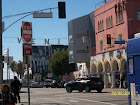

First and foremost, Los Angeles and Italians go back almost to the founding of the city. Francesco Fiore, a northern Italian vintner, bought land from the Mexican government around what is now Little Tokyo and planted wine grapes. He adopted Mexican citizenship and married into the prominent Coronel family (Antonio Coronel would be the last Hispanic mayor of Los Angeles until Antonio Villaraigosa). Italians married Mexicans in Los Angeles. They did it a lot in 1835 and they do it a lot today.
The Italian-Mexican legacy in Los Angeles is what the Italian-Irish connection is in New York; what the Italian-Polish connection is to Chicago. But, for many recent Angelenos, Mexicans only came to Los Angeles one day before they hired them as nannies, gardeners, and maids.
The Italians were so ingrained into early California and early Los Angeles life that the houses on Olvera Street, the oldest street in Los Angeles were built by Italians. Next time you eat at the ancient Mexican restaurant on Olvera Street, La Golondrina, know that it was the home of one Antonio Pelanconi who built his adobe in 1850. Italians came in large numbers in the late 19th Century and settled along with the Spanish speakers in their own Little Italy, right where Chinatown is today. The Italian Hall was the centerpiece of Los Angeles' Italian community for decades. It is on the corner of Cesar Chavez Ave. and Olvera Street. It's becoming the long-overdue Los Angeles Italian-American Museum. ANYBODY who lived in Los Angeles until 2000 remembers Little Joe's Italian Restaurant. People, even MrLA himself, questioned what an Italian restaurant was doing in Chinatown. The answer is that, at 102 years of age, it was there BEFORE there was a Chinatown. It had unquestionably great Italian food. One thing about the marinara sauces in L. A. Italian restaurants: they are fragrant and tomato soup-like that is unlike any other marinara sauces. Again, the types of tomatoes grown here plus the influence of Mexican cooks, with cilantro, played no small role. Little Joe's outlasted them all the great Italian restaurants of the '30's, '40's, '50's, and on to the present. Say LARUE'S, PERINO'S, PATSY D'AMORE'S, VILLA D'ITALIA to people who remember them and you'll see misty-eyed people who remember their great Italian food and glamour well. Oddly enough, the suburban Italian restaurants survived longer and better than the purely L. A. Italian places:
Petrillos, in San Gabriel and Glendora, since the early 1950's; Casa Bianca, still thriving in Eagle Rock, since 1955; Andre's in the Fairfax Shopping Center, across Farmer's Market, serving Italian food since 1962; Barone's, with three locations in the San Fernando Valley, since 1945. The tasty mini-chain, Tomato Pie, in South Pasadena, Silver Lake, and Fairfax District serve great, diverse pizzas, not to mention the venerable Scarantino's Italian Inn in Glendale, an institution in the Northeast Los Angeles area since 1967.
The two oldest Italian food establishments are still located in Los Angeles in the old Little Italy, which went from Chinatown northeast to Lincoln Heights, off the 5 Fwy. and south of Dodger Stadium. From the 1880's to the 1960's, Lincoln Heights was Little Italy, along with Little Croatia and Little Mexico. There stone houses all over Lincoln Heights, which Italian stonemasons built and lived in. They built 108 year-old Sacred Heart Catholic Church. They built the Di Biasi Building, across the street from the ancient/now hip, slick, and cool Airliner Lounge, where alt and indie rock bands play. MrLA, as a child and teenager, remembers seeing the Frank Pozzo Italian Sausage Company's building right next to the Starlight Movie Theater on North Broadway, the commercial heart of Lincoln Heights.
When Little Italy was at its height (World War I-World War II), there were wineries everywhere. By 1930, with Prohibition having been the law of the land for 10 years, wineries were all but a thing of the past in Los Angeles. The land became too valuable for factories, railroads, and diners to worry about preserving farms on the edge of the Los Angeles River. The San Antonio Winery held on supplying sacramental wine, then (after Prohibition) providing real wine to the Italians and French in Los Angeles (and those that love their cultures). For years, people would ask, "How can that winery still stay in Skid Row and expect to make a profit?" Make a profit it has and under the Riboli Familly, the San Antonio Winery is not only a major historical/cultural landmark, it's a thriving "port of entry" for people who wish to know about wine but don't have the money, gas, nor courage to travel out to the vineyards of Napa, Sonoma, or Temecula Valleys. The San Antonio Winery is the great-grandmother of all the boutique wine shops sprouting all over upscale Los Angeles. Their restaurant serves excellent Italian dishes, naturally paired with their wines. The Riboli Family truly welcomes their customers and sees that you all are treated as extensions of their family. MrLA and his friend, Michael, were unexpectedly given a private tour of the winery simply because they wanted to. Normally, such tours are scheduled far in advance and in large parties but MrLA literally stepped into an equipment check that the vintner (winemaker) for the San Antonio Winery was about to do before the dinner-commuter rush appeared.



If a fancy meal is not your thing or in your budget, turn back on one-block-long Lamar Street from the San Antonio Winery, turn left and half-block to your left, next to a decrepit smoke shop, sits Lanza's Italian Market, on North Main Street, literally a stone's throw east of the Los Angeles River, serving amazing, tasty, meaty, dripping, too-large-for-your-mouth-to-get-around-them sandwiches since 1926. Everything inside the market is time-traveling you to 1926, or at least, 1946. The deli counter looks as if it welcomed Truman on his campaign tour in '48. The sandwiches all come on an L. A.-style Italian bread that you have to taste to understand. MrLA has eaten Italian bread in major Italian-American cities, such as Chicago, San Francisco, and New Orleans but their bread doesn't have that fresh, spongy, doughy, springy, slightly fresh talcum-powder taste that old-time Los Angeles Italian bread has. Lanza's sandwiches are $4.75 and come with pickles so deli, they taste like they came from Canter's on Fairfax, but they didn't :-). The Italian Wedding Soup and Minestrone served there is heaping and cheap at $2.75, an enormous, delicious, satisfying, one-of-a-kind meal that takes you away to another world, a world that only exists at the remaining Little Italy eateries in Los Angeles: Lanza's Italian Market, the San Antonio Winery, and some of the most mouth-watering, gigantic sandwiches created in Los Angeles at the Eastside Market in current Chinatown/Echo Park.


This may not be kosher but anyone who can wangle an invitation to the annual Polenta Dinner at the mother church for Italians in Los Angeles, St. Peter's Church in Chinatown will discover one of Los Angeles' truly undiscovered culinary ecstasies. Screw Ford's Filling Station, Grace, and any "4 star" restaurant in this city, the polenta with sausage and marinara sauce is culinary orgasm, heaping plates full of this and other foods for the price of $25, benefitting the programs at the church. There was so much food left, complete polenta dinners, almost spilling out of their styrofoam containers, were being sold for $5.

Since pizza was the lure to get people to read about Italians in Los Angeles, to all those Easterners and Chicagoans, not to mention the "We Are All Northern Italians" of San Francisco and the good Neapolitans and Sicilians of Chicago: quit your whining and get aboard the reality that Los Angeles has some of the best pizza in the world, even inside Italy.
I can see the thousands of flexed hands flipping me off, Sicilian-style for saying such "heresy" but...................IT'S TRUE.
Pizza, pizza, EVERYWHERE in Los Angeles, and much of it is Italian food esctasy.
GREAT L. A.-STYLE PIZZA:
Michelangelo's Ristorante-www.michelangelo-silverlake.com
Casa Bianca-www.casabiancapizza.com
Petrillo's-www.menuism.com
El Morfi-www.elmorfigrill.com
Tomato Pie (Melrose/Fairfax and Silver Lake)-www.tomatopiepizzajoint.com
Johnnies-a chain throughout Los Angeles, predominantly Hollywood, West L. A., West Valley
Scarantino's Italian Inn-jamesscarantino@gmail.com
GREAT OLD-STYLE L. A. ITALIAN FOOD
Lanza's Italian Market-www.yelp.com/biz/lanza-market-los-angeles
San Antonio Winery-www.sanantoniowinery.com
Palermo's-www.palermorestaurant.net
Scarantino's Inn-www.scarantinos.com
Barone's Italian Restaurant-baronesfamousitalian.com
St. Peter's Italian Catholic Church-italianolosangeles.com
I Panini di Ambra-www.thepaninilady.com
Eastside Market-www.eastsidemarket.com
























